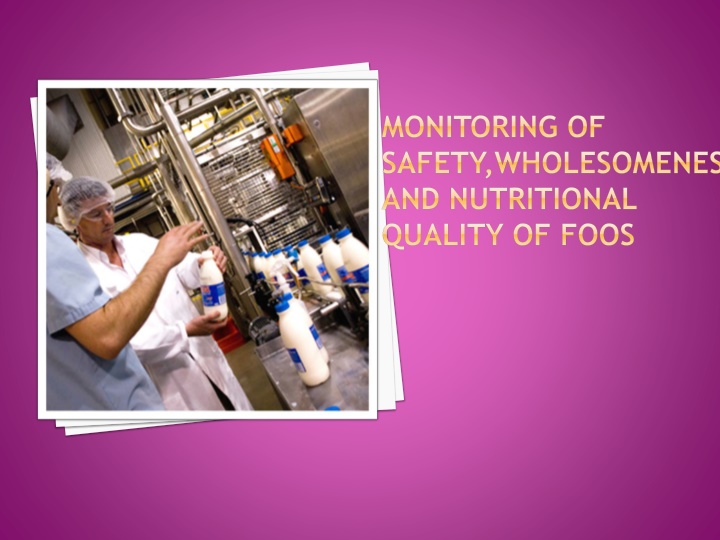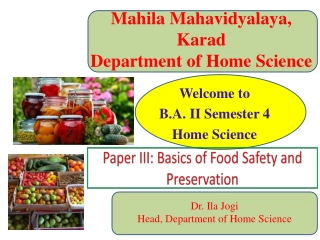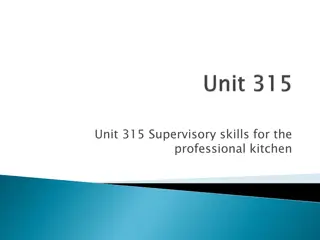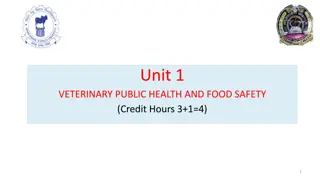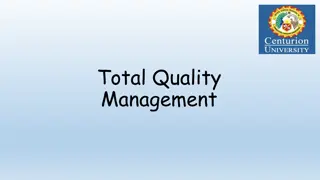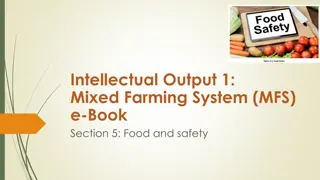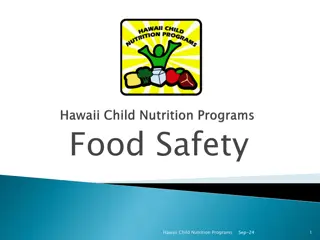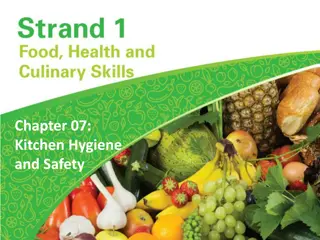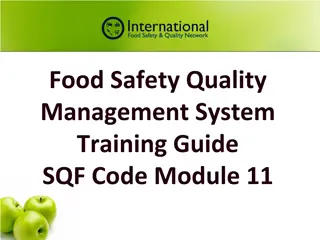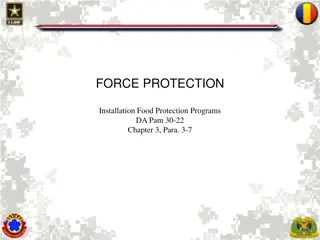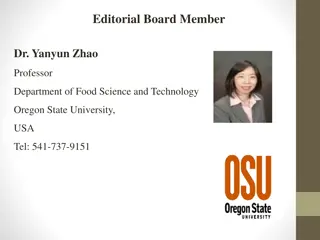Ensuring the Safety and Quality of Food through HACCP Principles
Food quality and safety are crucial for consumer well-being. Effective programs such as HACCP help identify, evaluate, and control food safety hazards. This systematic approach focuses on prevention rather than reaction, ensuring the production of wholesome and nutritious food. Learn about the key principles and requirements for implementing a successful HACCP plan.
Download Presentation

Please find below an Image/Link to download the presentation.
The content on the website is provided AS IS for your information and personal use only. It may not be sold, licensed, or shared on other websites without obtaining consent from the author.If you encounter any issues during the download, it is possible that the publisher has removed the file from their server.
You are allowed to download the files provided on this website for personal or commercial use, subject to the condition that they are used lawfully. All files are the property of their respective owners.
The content on the website is provided AS IS for your information and personal use only. It may not be sold, licensed, or shared on other websites without obtaining consent from the author.
E N D
Presentation Transcript
MONITORING OF SAFETY,WHOLESOMENESS AND NUTRITIONAL QUALITY OF FOOS
INTRODUCTION Food quality encompasses the basic composition of foods and aspects concerning food safety. Consumers have the right to a good quality and safe food supply, and government and food industry actions are needed to ensure this. Effective food quality programmes are essential and may comprise a variety of measures, such as laws, regulations and standards, together with systems for effective inspection and compliance monitoring including laboratory analysis. and safety control
HACCP HACCP
WHAT IS HACCP? HACCP (Hazard Analysis Critical Control Point) is a systematic way to identify, evaluate, and control food safety hazards. Hazards are biological, chemical, or physical agents likely to cause illness or injury if they are not controlled. HACCP prevents food safety hazards rather than reacts to food safety hazards. To develop a HACCP plan, one follows the seven principles. 5 Food Safety Plan
WHEN IS A HACCP PLAN REQUIRED? Not all foodservice establishments are required to have a HACCP plan. If the following processes are conducted in the operation, a HACCP plan is needed: Vacuum package food Service of raw meats Package fresh squeezed orange juice Serve shellfish directly from a tank Curing or smoking food for preservation 6 Food Safety Plan
1: CONDUCT A HAZARD ANALYSIS Identify hazards associated with a specific menu item. Prepare a flow diagram that outlines all handling/preparation steps from receiving to service. List likely hazards associated with each step. Identify how to prevent the hazards at each step. Hazards can be biological, chemical, or physical. List the hazards that are likely to occur and that will cause severe consequences if not controlled. Hazards that are low risk and that are not likely do not need to be considered. 7 Food Safety Plan
2: DETERMINE CCPS A control point is any point, step, or procedure where biological, physical, or chemical factors can be controlled. A critical control point (CCP) is a point, step, or procedure where an identified hazard can be prevented, eliminated, or reduced to acceptable levels. Critical control points are monitored much more frequently than are control points. 8 Food Safety Plan
3: ESTABLISH CRITICAL LIMITS This step involves establishing criteria that must be met to prevent, eliminate, or the reduce the identified hazard at the CCP so that the food is safe to eat. Examples of critical limits are: temperature, time, physical dimensions, water activity, pH, and available chlorine Critical limits can come from regulatory standards and guidelines, scientific literature, experimental studies, and consultation with experts. 9 Food Safety Plan
4: ESTABLISH MONITORING PROCEDURES Monitoring is a planned observation or measurement: to determine if a CCP is under control Examples of monitoring include: Visual observations Temperature measurements Time assessment pH measurements Water activity measurements 10 Food Safety Plan
5: ESTABLISH CORRECTIVE ACTIONS Corrective actions focus on: what to do when a food does not meet the critical limit. Example of a corrective action: The temperature of a hamburger is 140 oF after cooking (a CCP). The critical limit is cooking the hamburger to 155 oF or hotter. Continue cooking the hamburger until it is 155 oF or hotter. Throwing out food might be a corrective action. Maintain records of all corrective actions taken. 11 Food Safety Plan
6: ESTABLISH VERIFICATION PROCEDURES Four phases of verification needed for a HACCP plan: 1. Determine that the critical limits at all CCPS are sound. 2. Make sure that the establishment s HACCP plan is being properly implemented. 3. Have regulatory personnel review the plan to make sure that it is being properly implemented. 4. Check the accuracy of all monitoring equipment. 12 Food Safety Plan
7: ESTABLISH RECORD KEEPING The following make up the records of a HACCP Plan List of HACCP team and their assigned responsibilities Description of each menu item Flow diagram for each menu item indicating CCPs Hazards associated with each CCP and preventive measures Critical limits Monitoring procedures Corrective actions plans Record keeping procedures Procedures for verification of the HACCP plan 14 Food Safety Plan
PREREQUISITE PROGRAMS Focus on employees, facilities, and equipment. Examples of prerequisite programs include: Illness policy Cleaning and sanitizing procedures Garbage removal Pest control Equipment selection Employee hygiene 15 Food Safety Plan
GOOD MAUFACTURING PRACTICES
GOOD MANUFACTURING PRACTICES control. GMPs, sanitation, and hygiene are key to microbiological Using high-quality raw materials with small populations of micro-organism. Selecting food processing equipment that is easy to clean and does not harbor contaminants. Sanitizing equipment regularly to prevent build up of bacteria. Checking equipment for cleaning adequacy with microbial assays. Filtering the air of food processing areas to reduce airborne contaminants. Training personnel to use hygienic food handling practices. 1. 2. 3. 4. 5. 6.
ELEMENTS OF GOOD MANUFACTURING PRACTICES
1.ORGANISATIONAL AND PERSONNEL The plant management shall take all reasonable measures and precautions to ensure . . . : Cleanliness. All persons working in direct contact with food, food contact surfaces, and food packaging materials shall conform to hygienic practices while on duty to the extent necessary to protect against contamination of food. Washing hands thoroughly (and sanitizing if necessary to protect against contamination with undesirable microorganisms) in an adequate hand washing facility before starting work, after each absence from the work station, and at any other time when the hands may have become soiled or contaminated. Removing all unsecured jewellery and other objects that might fall into food, equipment, or containers.
Wearing, where appropriate, in an effective manner, hair nets, headbands, caps, beard covers, or other effective hair restraints. Education and training. Personnel responsible for identifying sanitation failures or food contamination should have a background of education or experience, or a combination thereof, to provide a level of competency necessary for production of clean and safe food. Food handlers and supervisors should receive appropriate training in proper food handling techniques and food protection principles and should be informed of the danger of poor personal hygiene and insanitary practices.
2.BUILDINGS AND FACILITIES Properly storing equipment, removing litter and waste, and cutting weeds or grass within the immediate vicinity of the plant buildings or structures that may constitute an attractant, breeding place, or harborage for pests. Provide sufficient space for such placement of equipment and storage of materials as is necessary for the maintenance of sanitary operations and the production of safe food.
3.EQUIPMENTS Equipment and utensils, describing the design, material, and workmanship to provide adequate cleaning and maintenance.
4.PRODUCTION AND PROCESS CONTROLS Processes and controls, adequate sanitation principles for unit operations in the receiving, inspecting, transporting, segregating, preparing, manufacturing, packaging, and storing of food are defined. Raw materials and other ingredients shall either not contain levels of microorganisms that may produce food poisoning or other disease in humans, or they shall be pasteurized or otherwise treated during manufacturing operations so that they no longer contain levels that would cause the product to be adulterated.
Maintaining frozen foods in a frozen state Maintaining hot food at 140 F (60 C) or above Monitoring the water activity of food Monitoring the pH of raw materials, food in process, and finished food Controlling the amount of acid or acidified food added to low acid food Storage and transportation of finished food shall be under conditions that will protect food against physical, chemical and microbial contamination as well as against deterioration of the food and the container.
5.PACKAGING AND LABELING CONTROL Label is a display of a written, printed or graphic matter upon the immediate container of any article. Labelling is the label and any other packaging material or container that is printed (ex. IFU, advertising materials) Procedures must exist that document receiving, identity, storage, handling, sampling, and testing of labels and ensure that integrity is maintained throughout production and use of product.
Labeling must be separated physically in storage to avoid mix-ups. Wording of labels cannot be changed unless the FDA is notified. Labeling must be inspected prior to issuing to production. All labels must be reconciled (accounted for) if not 100% inspected.
6. LABORATORY CONTROL Written procedures must be established & followed All actions must be documented at the time of performance Calculations need to be recorded Second person must review records Data must be directly recorded into appropriate records Equipment, software, and methods must be validated An Out-of-Specification (OOS) result must be investigated and a root cause identified Laboratory data is considered to be a quality recordWritten procedures must be established & followed
8. HOLDING AND DISTRIBUTIONS Warehousing procedures should address Quarantine of drug products storage of products under appropriate conditions Distribution procedures should address FEFO (First Expiring First Out) traceability of product lots/batches
9.RECORDS AND REPORTS Quality Records are the proof that the procedures were followed and they show traceability of product. Examples: Lot History Records Laboratory Notebooks Protocols Reports Logbooks Distribution Records Complaint Files
WEBSITE REFRENCES http://www.fda.gov (Food and Drug Administration) http://www.fda.gov/foi/warning.htm (FDA Warning Letters) http://www.access.gpo.gov/uscode/title21/chapter9_.html (Food Drug and Cosmetic Act) http://www.gpoaccess.gov/fr/index.html (Federal Register) http://www.fda.gov/opacom/morechoices/industry/guide dc.htm (Guidance Documents) http://www.ich.org (International Conference on Harmonization) http://www.pda.org (Parenteral Drug Association)
THANK YOU THANK YOU
